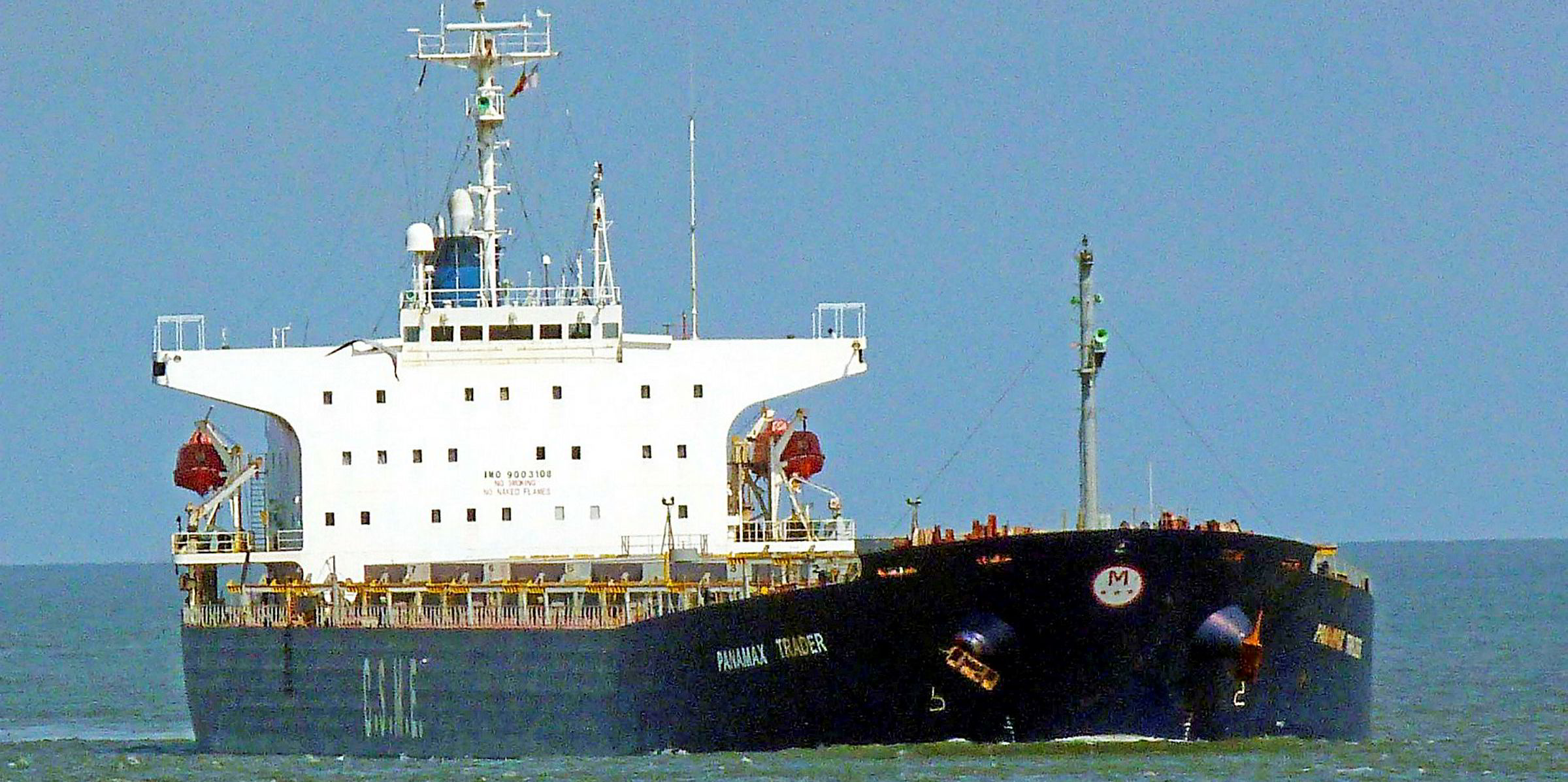The waters of the Red Sea were calm as the Panamax Trader made its way through the Tiran Straits, carrying a cargo of rock phosphate.
It was just after sunrise on 10 November 2014 but the tranquillity was short-lived after the 69,300-dwt bulker began to deviate from its course.
Six or seven minutes later, it made a head-on impact with a coral reef near the shore, setting in motion a chain of events that led to the London courts.
The 24-year-old vessel sank five months later in March 2015 while underway to Djibouti for repairs and was deemed an actual total loss. The crew abandoned ship and were unharmed.
The panamax was insured for $29m, but the insurers refused to pay out.
The legal case began in 2017, when the Panamax Trader’s vessel-owning company, Double Eight Marine, filed a claim in London’s High Court against Royal & Sun Alliance and 15 other insurers.
The shipowner accused them of wrongly refusing to indemnify it for the bulker’s loss under a hull and machinery policy and an increased value policy, together worth $29m in coverage, according to publicly available court documents.
The insurers — which include QBE Insurance Europe, Allianz Global Corporate & Specialty, Catlin Syndicate and the Swedish Club — refused to indemnify the owner because they claim the vessel was sunk deliberately.
In their defence, the insurers claimed that the claimant and its beneficial owners had a “clear financial motive” to scuttle the vessel, given that its insured value was around $25m more than its market value when it sank.
Double Eight Marine and its principals strenuously denied that the ship was sunk deliberately, by their own hand or by others’, and asserted that there would have been no financial imperative to do so.

The shipowner said the vessel’s value, whether for scrap or sale, was irrelevant because the company was not a prospective seller, nor had it been asked by its bank to sell the ship.
Nor was there any cross-collateralisation between the Panamax Trader and other vessels held by the same owners or any personal guarantee from debt holders, Double Eight Marine said.
The case was due to go to trial in London in June when proceedings were settled on the day before they were set to begin. Proceedings were stayed after the parties reached an agreement out of court on 12 June, according to court papers. TW+ has learnt that the agreement was signed on confidential terms.
Less than two weeks earlier, Mr Justice Richard Jacobs had granted the insurers’ application to investigate the “authenticity and provenance” of four photographs submitted by Double Eight Marine as evidence.
The judge also gave the go-ahead for forensic IT analysis of computers used by employees of Chian Spirit Maritime, which managed the Panamax Trader, as well as the company’s file server and email system.
According to court papers, Double Eight Marine is beneficially owned by Panagiotis and Nikolaos Madias, who run Chian Spirit Maritime and are among those who would have had their desktop and laptop computers analysed.
Computers belonging to Chian Spirit’s technical manager, safety and quality manager and assistant accountant would also have been examined, under Jacobs’ order.
In early 2019, the judge ordered Double Eight and its interested parties to turn over papers to show the vessel’s ownership details, cargo and safety record.
He also ordered that the claimants hand over all of Chian Spirit Maritime’s management accounts, bank statements and other similar relevant financial records from November 2013 to March 2016.
Impact with the reef inflicted minimal damage on the Panamax Trader’s hull, according to filings from both sides. However, the shipowner claims that the collision bulkhead’s structure was damaged in the impact.
Corrugations in the holds had been strengthened with gussets and shedder plates, but Double Eight Marine claims latent defects caused them to fail after the vessel ran aground.
The vertical stiffeners were also corroded, which was allegedly shown in the claimant’s photographic evidence.

This ultimately caused the bulkhead to collapse, as the weakened structure was fatigued by cyclic loading forces, leading to seawater ingress on the way to Djibouti and the ship’s ultimate sinking, the owner argues.
The defence called this theory “so implausible as to give rise to possibilities which are no more than fanciful or remote”.
The flooding that caused the vessel to sink is a “peril of the sea” against which the ship was insured, the owner said in its claim. It was also insured against two other “perils”: a latent defect in the hull and negligence by the master, officers or crew.
The insurers, however, alleged that a very different chain of events led to the sinking, according to unproven court documents.
The vessel hit the reef, which was charted, while underway in good visibility and good weather just after sunrise.
Before the incident, it had received warnings from the Gulf of Aqaba Vessel Traffic Service that it had deviated and should change back to a safe course.
The defence claims that similar warnings were transmitted by Egyptian and United Nations vessel traffic services around the same time, but the shipowner denies this.
The ship’s steering was changed from automatic to manual mode less than 10 minutes before the incident.
The owner claims this was due to a not-uncommon error made by the chief officer, who accidentally put the ship in “non-follow-up” mode, which locked the rudder into position while the vessel was off course.
The Panamax Trader is the second Chian Spirit-managed ship to become a total loss after grounding, leading to a court battle with insurers. The previous case ended successfully for the owner, with the defence of the insurers being rejected.
In 2009 the 35,000-dwt bulker Irene EM (built 1980) grounded off India six weeks after being released by Somali pirates. A panel of 20 underwriters, led by International General Insurance, refused to pay out an $18m claim by the ship’s Liberian owner, Venetico Marine. But in November 2013 a High Court judge in London found for the owner, concluding that the Irene EM was a constructive total loss as a result of the grounding and that this was an insured peril.
Venetico Marine was awarded the claimed amount, plus interest but less the scrap proceeds, which amounted to more than $3m.
The ship ended up perpendicular to the shore at the moment it struck the reef, according to the defence. “In other words, she had turned about 90 degrees from her intended course by the time the impact with the reef was made,” the insurers said.
After the impact, crew did not save or recover the bridge’s voyage data recorder (VDR), as required under the Solas convention. The insurers called this “dereliction of normal standards of seamanship”.
The shipowner denied this and said there was nothing unusual in it.
In any case, it added, the Egyptian Navy boarded the Panamax Trader shortly after the impact and “effectively took control of the vessel”, leaving no opportunity for the VDR to be recovered.
Double Eight Marine blames a common fault with the gyro compass for the vessel’s loss of control, which it claims happened again while the bulker was underway to Djibouti.
It maintains its explanations were plausible and a true account of what happened, while the insurers argued that Double Eight did not offer any “non-fanciful” or consistent explanation for the impact or why the vessel’s course was not corrected.
The insurance companies’ defence was based on the theory that Double Eight Marine had intended to sink the vessel and use the impact with the reef as the explanation for the sinking.
Double Eight vehemently rejected this claim, repeatedly calling the theory “fanciful and ‘remote’” in its court filings.
The insurers gave a detailed outline of how they suspected the Panamax Trader was sunk, but had no direct evidence to support their theories.
The impact, they say, would not have damaged the collision bulkhead at the speed the vessel was sailing, 10-11 knots. The owner denies this.
Either holes were cut in the bulkhead to allow ingress of water, or underwater explosives were used to blow holes in the steel, the insurers alleged.
They put forward theories as to how this might have happened, and added: “The defendants will say that there was at least one person on board at the time of the sinking with the skillset necessary either to sink or co-ordinate the sinking of the vessel using explosives.”
Double Eight vehemently denied the “speculative” theory and called it implausible.
For one thing, it said, if explosive devices had been brought onboard from the shore, they would have to have made it past the Egyptian Navy.
The Panamax Trader was anchored and safeguarded at the Egyptian naval vase at Safaga after hitting the reef, making it unlikely that explosives could have been brought onboard via the base, Double Eight said in court papers.
En route to Djibouti, the master ordered the abandonment of the vessel when water began to pour in, flooding the collision bulkhead, second watertight compartment and into the first hold.
“The master had no way of knowing if the vessel (a laden bulk carrier) could survive the flooding of a second compartment,” the owner said.
The defendants’ lawyers, Stephenson Harwood, declined to comment when contacted for this story. HFW, the claimant’s lawyers, also declined. Chian Spirit Maritime said a confidential settlement of the claim was concluded just before the trial.
The insurers argued that the abandonment was premature, given that the vessel was not in immediate danger, but the shipowner said flooding had already exceeded the regulatory minimum.
It said the master prioritised the crew’s safety and waited until they had boarded the lifeboats before calling for emergency assistance.
A salvage tug had been accompanying the ship to Djibouti, sailing ahead of the vessel. The insurers claimed that the master did not call the tug for assistance, but the shipowner said he did so around three minutes after crew had boarded the lifeboats.
Likewise, Double Eight said it was reasonable not to activate the emergency position-indicating radio beacon until the sinking was imminent. The insurers disputed this.
A trial of the case would have decided what happened to the ship and whether the claims of the insurers held water.
The agreement on confidential terms means the market remains unaware of how these issues were resolved and will not be able to evaluate the basis on which insurers reject such claims and defend court actions brought against them.
A trial would also have demonstrated how such claims can be investigated and how the Commercial Court in London decides such conflicting claims.
How the Panamax Trader came to sink cannot be known or proved — it sank in waters too deep to be inspected. Somewhere, more than a kilometre below the surface of the Red Sea, the vessel lies with all the answers.





